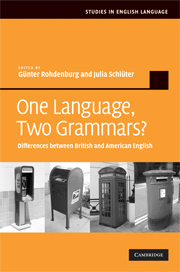Book contents
- Frontmatter
- Contents
- List of figures
- List of tables
- List of contributors
- Introduction
- 1 Colonial lag, colonial innovation or simply language change?
- 2 Compound verbs
- 3 The formation of the preterite and the past participle
- 4 Synthetic and analytic comparatives
- 5 Phonology and grammar
- 6 Prepositions and postpositions
- 7 Argument structure
- 8 Reflexive structures
- 9 Noun phrase modification
- 10 Nominal complements
- 11 Non-finite complements
- 12 The present perfect and the preterite
- 13 The revived subjunctive
- 14 The mandative subjunctive
- 15 The conditional subjunctive
- 16 Tag questions
- 17 The pragmatics of adverbs
- 18 How different are American and British English grammar? And how are they different?
- 19 New departures
- Bibliography
- Index
5 - Phonology and grammar
Published online by Cambridge University Press: 03 July 2009
- Frontmatter
- Contents
- List of figures
- List of tables
- List of contributors
- Introduction
- 1 Colonial lag, colonial innovation or simply language change?
- 2 Compound verbs
- 3 The formation of the preterite and the past participle
- 4 Synthetic and analytic comparatives
- 5 Phonology and grammar
- 6 Prepositions and postpositions
- 7 Argument structure
- 8 Reflexive structures
- 9 Noun phrase modification
- 10 Nominal complements
- 11 Non-finite complements
- 12 The present perfect and the preterite
- 13 The revived subjunctive
- 14 The mandative subjunctive
- 15 The conditional subjunctive
- 16 Tag questions
- 17 The pragmatics of adverbs
- 18 How different are American and British English grammar? And how are they different?
- 19 New departures
- Bibliography
- Index
Summary
Introduction
Based on the assumption that functional constraints underdetermine the precise shape a grammar can take, this contribution explores the influence of a rhythmic universal on grammatical variation in BrE and AmE. Although the historical division between the two national varieties under consideration has occurred only recently (by the standards of linguistic evolution), corpus analyses reveal significant dissimilarities in the ways the phonological universal is implemented. This provides a small-scale example of the interaction between system-internal, grammatical choices and system-external, functional conditions of language use.
At the centre of the discussion is the so-called Principle of Rhythmic Alternation, i.e. the tendency to separate stressed syllables by intervening unstressed ones. In previous work (cf. Schlüter 2002, 2003, 2005), its influence on the shaping of English grammar has been demonstrated. In the present contribution, the emphasis will be placed on dissimilarities in its implementation in the two major national varieties of English. For this purpose, two domains of grammatical variation will be focused on that have so far received little attention in the context of British–American differences and have therefore never been subjected to a thorough analysis. This concerns the choice between mono- and disyllabic past participles of the verbs light and knit and the positional alternation of the degree modifier quite in combination with the indefinite article.
- Type
- Chapter
- Information
- One Language, Two Grammars?Differences between British and American English, pp. 108 - 129Publisher: Cambridge University PressPrint publication year: 2009
- 3
- Cited by



